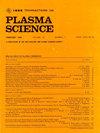丙烯酸前体单体脉冲等离子体聚合裁剪膜化学研究
IF 1.5
4区 物理与天体物理
Q3 PHYSICS, FLUIDS & PLASMAS
引用次数: 0
摘要
变占空比脉冲等离子体聚合工艺是控制薄膜化学性质和沉积速率,从而控制薄膜厚度的有效技术。本研究以丙烯酸(AA)为前驱单体,采用脉冲等离子体聚合技术在硅片上沉积含羧基的薄膜。用表面轮廓仪测量了薄膜的厚度。通过对水的接触角测量来评价膜的润湿性。此外,利用x射线光电子能谱(XPS)、傅里叶变换红外光谱(FTIR)和原子力显微镜(AFM)对这些薄膜进行了表征,以了解薄膜的化学性质和表面粗糙度。XPS结果显示,连续波(CW)和5-/25 ms脉冲的O/C比值分别从0.39增加到0.51。连续波条件下沉积膜的接触角为63.92°,随着脉冲关闭时间的增加,接触角有系统地减小,在5-/25 ms脉冲下沉积膜的接触角达到43.12°,表明膜具有亲水性。这些结果表明,脉冲等离子体聚合可用于各种应用中膜化学的系统控制。本文章由计算机程序翻译,如有差异,请以英文原文为准。
Tailoring Film Chemistry Using Pulsed Plasma Polymerization of Acrylic Acid Precursor Monomer
Variable duty cycle pulsed plasma polymerization process is an effective technique to control film chemistry and deposition rate, thereby controlling film thickness. In the present investigation, the pulsed plasma polymerization technique was used to deposit thin films containing carboxylic groups on silicon wafer using acrylic acid (AA) as a precursor monomer. The thickness of films was measured with surface profiler. The wettability of films was evaluated by contact angle measurement with respect to water. Furthermore, these films were characterized by X-ray photo-electron spectroscopy (XPS), Fourier transform infrared spectroscopy (FTIR), and atomic force microscopy (AFM) to understand film chemistry and surface roughness. The XPS results revealed that O/C ratio increased from 0.39 to 0.51 for continuous wave (CW) and 5-/25-ms pulse, respectively. Contact angle for the film deposited under CW condition was found to be 63.92°, which decreased systematically with the increase in off time of the pulse and finally reaches to 43.12° for the film deposited under 5-/25-ms pulse, indicating hydrophilic nature of the film. These results showed that pulsed plasma polymerization can be used for systematic control of film chemistry for various applications.
求助全文
通过发布文献求助,成功后即可免费获取论文全文。
去求助
来源期刊

IEEE Transactions on Plasma Science
物理-物理:流体与等离子体
CiteScore
3.00
自引率
20.00%
发文量
538
审稿时长
3.8 months
期刊介绍:
The scope covers all aspects of the theory and application of plasma science. It includes the following areas: magnetohydrodynamics; thermionics and plasma diodes; basic plasma phenomena; gaseous electronics; microwave/plasma interaction; electron, ion, and plasma sources; space plasmas; intense electron and ion beams; laser-plasma interactions; plasma diagnostics; plasma chemistry and processing; solid-state plasmas; plasma heating; plasma for controlled fusion research; high energy density plasmas; industrial/commercial applications of plasma physics; plasma waves and instabilities; and high power microwave and submillimeter wave generation.
 求助内容:
求助内容: 应助结果提醒方式:
应助结果提醒方式:


